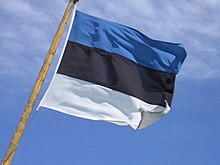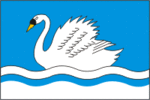Flag of Estonia
| Flag of Estonia | |
|---|---|
 |
|
| Vexillological symbol : |
|
| Aspect ratio: | 7:11 |
| Officially accepted: | August 7, 1990 |
The flag of Estonia was first introduced on November 21, 1918 and again on August 7, 1990. Proposals for a completely new national flag could not prevail.
description
The national flag shows three equally wide horizontal stripes in (from top to bottom) blue, black and white ( Estonian: sinimustvalge ). According to the Estonian Flag Ordinance, which came into force on January 1, 2006, the blue is set to the color value Pantone 285C and the proportions to 7:11. The blue stands for loyalty and trust, the black for the ancestors and the past and the white for the snow and the future.
history
It was first known as the flag of the Estonian Student Association (Estonian: Eesti Üliõpilaste Selts or EÜS) a student union at the University of Tartu , for which it was consecrated on June 4, 1884 in the pastorate of Otepää . It was later associated with Estonian nationalism and was used as the Estonian flag during the first Estonian independence from 1918. The flag was formally declared the national flag on November 21, 1918.
After the invasion of the Soviet Union in 1940, the flag was banned. She was overtaken at Pikk Hermann on June 21, 1940, although Estonia was formally still independent. The following day it was hoisted again along with the Soviet flag until it was finally banned on July 27th. On August 6, 1940, the Estonian Soviet Socialist Republic officially became part of the Soviet Union.
By decree of the Provisional Presidium of the Supreme Soviet of the Estonian SSR, the first flag of the Estonian SSR was introduced on October 31, 1940. The aspect ratio of height to width was 1: 2. The flag was a red cloth with the hammer and sickle symbols in yellow in the upper left corner. Above this was the Estonian abbreviation ENSV ( Eesti Nõukogude Sotsialistlik Vabariik - Estonian Soviet Socialist Republic) in sans serif in yellow letters .
During the German occupation from 1941 to 1944, the Estonian flag was accepted as a symbol of ethnic Estentism, but not as a national flag. After the Germans withdrew in September 1944, the Estonian flag was raised again. To this end, the Soviet flag was hoisted on September 22; again the Estonian flag disappeared soon afterwards.
The second flag of the Estonian SSR, popularly known as the "wave flag" ( lainelipp ), was introduced by an ordinance of the Presidium of the Supreme Soviet on February 6, 1953 and confirmed by Section 167 of the Constitution of the Estonian SSR of October 7, 1977.
The aspect ratio of height to width was 1: 2. The flag was made of red cloth. In the lower half of the flag there were two smaller white wavy strips horizontally above a large light blue wavy strip, which were separated by a small blue strip. Five peaks of the waves could be seen. The waves should symbolize the Baltic Sea .
The flag of the Estonian SSR differed from the flag of the Latvian SSR in that it had sharper-edged wave crests and a wavy red stripe below the light blue stripe that was missing from the flag of the Latvian SSR. This red stripe took up about a fifth on the flag of the Estonian SSR.
On the front of the flag were - as in the flag of the Soviet Union - in Gösch a gelbumrandeter five-pointed red star and an underlying hammer-and-sickle symbol to see. In most cases the star, hammer and sickle were missing on the back. The 1977 Constitution of the Estonian SSR made this explicit.
It was only during perestroika that the tricolor could be seen in public again. In 1988, showing the original flag of the Republic of Estonia in public was no longer a criminal offense. On February 24, 1989, the 71st anniversary of Estonia's declaration of independence in 1918, they were raised again on Pikk Hermann at the seat of government in Tallinn . It was officially declared the national flag by the Supreme Council of the Republic of Estonia on August 7, 1990, shortly before Estonian regained independence.
In 2001 the politician Kaarel Tarand suggested replacing the tricolor flag with a cross flag in the style of the Scandinavian countries . Proponents of the proposal believe that the tricolor is the symbol of an Eastern European country, while the cross would symbolize Estonia's ties to the Nordic countries . There are close contacts with Finland in particular due to the kinship of languages and cultures. As early as 1919 there were proposals for a flag with a cross design. However, since the tricolor enjoys great popularity as an important national symbol, Tarand's proposal was not taken up.
 ? Flag of the Governorate of Livonia in the Russian Empire (1721-1917)
? Flag of the Governorate of Livonia in the Russian Empire (1721-1917)
7:11 ? Flag of Estonia (1918-1940)

1: 2 ? Flag of the Estonian SSR (1940-1953)

1: 2 ? Flag of the Estonian SSR (1953-1990)

Subnational flags of Estonia
The flags of the 15 districts ( maakond ) of Estonia consist of two horizontal stripes white and green and carry the coat of arms of the district in the white field.
The municipalities of Estonia also have their own flags in very different designs.
Other flags of Estonia
Web links
- Flags of the World - Estonia (English)
- History of the flags of Estonia (Estonian)
swell
Individual evidence
- ↑ Archive link ( Memento of the original from June 26, 2007 in the Internet Archive ) Info: The archive link was automatically inserted and not yet checked. Please check the original and archive link according to the instructions and then remove this notice.
- ↑ Archive link ( Memento of the original from May 18, 2008 in the Internet Archive ) Info: The archive link was inserted automatically and not yet checked. Please check the original and archive link according to the instructions and then remove this notice.
- ↑ Eesti Päevaleht, December 3, 2001, KAAREL TARAND: Lippude vahetusel ( Memento of the original from January 26, 2008 in the Internet Archive ) Info: The archive link was inserted automatically and has not yet been checked. Please check the original and archive link according to the instructions and then remove this notice. (Estonian)














